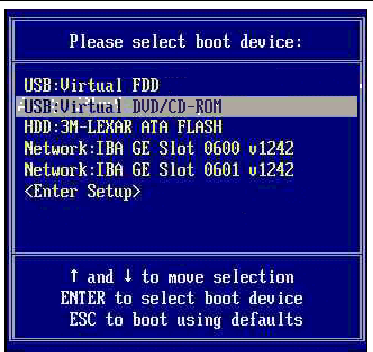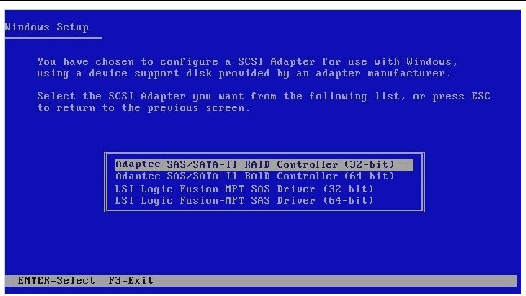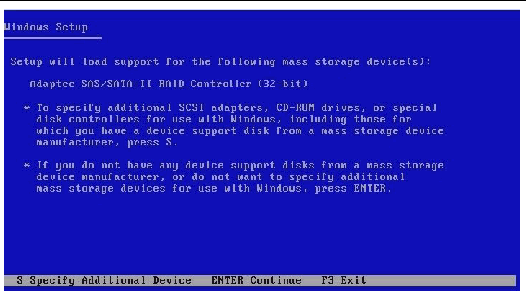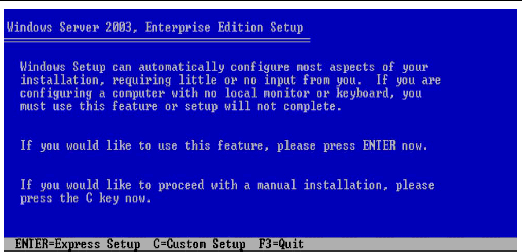| C H A P T E R 6 |
|
Installing Windows Server 2003 |
This chapter describes how to install the Windows Server 2003 operating system onto a Sun Blade X6250 server using the Windows Server 2003 media.
Before beginning the operating system installation, make sure that the following requirements are met for all installation methods:
 -based), choose one of the following installation options that best matches your needs:
-based), choose one of the following installation options that best matches your needs:
FIGURE 6-1 Example Startup Screen Showing Existing Sun Blade REM Array Volume

| Note - More information about using the controller’s BIOS configuration utility is described in the Sun Blade X6250 Server Module Installation Guide (820-1182). |
For requirements specific to the mass storage driver and Windows Server 2003 media delivery methods that you have chosen, see TABLE 6-1.
Follow these steps to install the Microsoft Windows Server 2003 software onto your Sun Blade X6250 server module.
| Note - The Windows installation will format the drive you designate as the boot disk, any pre-existing data on that disk will be lost. |
1. Make sure that you have completed all of the requirements listed in Installation Requirements.
3. Press F8 when the Press F8 for BBS POPUP prompt appears on the BIOS POST screen (see FIGURE 6-2).
The BBS POPUP menu will allow you to select a boot device.

4. Once the BIOS POST process is complete, the Boot Device menu appears (see FIGURE 6-3). If you have selected the Windows Local installation method, insert the Windows media CD in the server’s DVD drive now.
FIGURE 6-3 Boot Device Menu Example

5. Select the DVD/CD-ROM drive or the CD image from the Boot Device menu and press Enter.
If prompted with Press any key to boot from CD, quickly press any key.
The Windows Setup process begins.
6. Press F6 when you see the following prompt at the bottom of the screen during the Windows Setup process:
Press F6 if you need to install a third party SCSI or RAID driver.
| Note - The prompt is displayed in the early stages of Windows Setup and lasts for approximately five seconds and is easy to miss. If you do not press F6 while the prompt is being displayed, the screen allowing you to specify additional drivers is not displayed and the installation will fail. You will need to restart the system and go back to Step 3. |
After pressing F6, a screen will appear providing you with the option to specify additional mass storage devices.
FIGURE 6-4 Specify Additional Device Screen

7. Make sure that the mass storage drivers are accessible according to the mass storage driver installation method that you have selected.
8. Press S to specify additional devices.
A screen appears listing the available drivers. Refer to FIGURE 6-5.
FIGURE 6-5 Example Select Mass Storage Adapter Screen

9. Select the appropriate mass storage controller driver for your server depending on the version of Windows (32-bit or 64-bit) you are installing, and then press Enter:
Windows Setup will then display your selection.
10. Windows Setup lists the mass storage driver to be installed (example shown in FIGURE 6-6). Press Enter to continue.
FIGURE 6-6 Example Specify Additional Device Screen With Sun Blade RAID 5 Expansion Module Selected

11. Confirm your choice and press Enter to continue.
The Welcome to Setup screen is displayed.
12. At the Welcome to Setup screen, press Enter to continue.
The Setup Selection screen is displayed.
FIGURE 6-7 Setup Selection Screen

13. Press either Enter to select Express Setup, or C to select Custom Setup.
If you created a RAID volume on your boot disk as part of your prerequisite preparations for installing Windows, press C to select Custom Setup and manually partition the disk. Make sure to reserve a minimum of 200 MB of unpartitioned space at the end of the drive. Otherwise, press Enter to select Express Setup.
14. Follow the on-screen instructions to complete the initial setup of Windows Server 2003 until you are prompted with the following message:
Remove disks or other media. Press any key to restart.
When this message appears you will need to complete one of the following steps, depending on which driver delivery method you have chosen, to complete the installation:
Then, press any key to restart the system and complete the Windows Server 2003 Installation.
15. Proceed to Chapter 8 “Updating the Critical Server-Specific Drivers.”
Copyright © 2008 Sun Microsystems, Inc. All Rights Reserved.